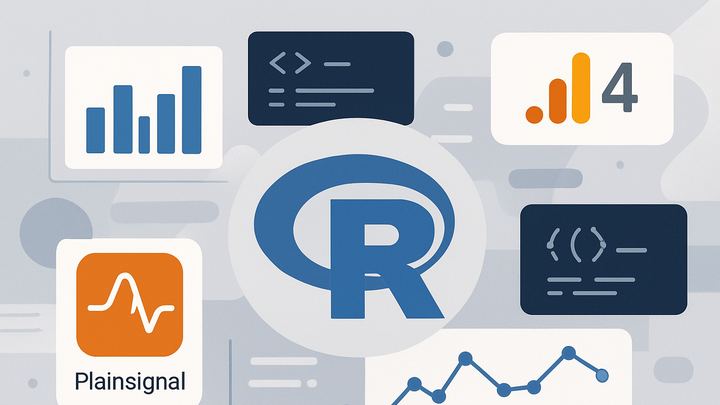Published on 2025-06-22T04:45:55Z
What is R? Examples of R in Analytics
R is a free, open-source programming language and software environment for statistical computing and graphics. Widely adopted in analytics, data science, and research, R provides a rich ecosystem of packages on CRAN to support tasks ranging from data manipulation and visualization to advanced statistical modeling and machine learning. Through RStudio and other IDEs, users can interactively explore data, build reproducible reports with R Markdown, and deploy interactive dashboards with Shiny. In analytics workflows, R integrates seamlessly with platforms like Google Analytics 4 and PlainSignal, allowing analysts to import, analyze, and visualize web and application metrics. Whether you are performing exploratory analysis, predictive modeling, or generating automated reports, R’s extensibility and robust community make it an indispensable tool.
R (statistical programming language)
Open-source language for statistical computing and graphics, widely used in analytics, data science, and visualization.
Why R Matters in Analytics
R combines statistical rigor with an extensive package ecosystem to handle every step of an analytics workflow, from data import and cleaning to advanced modeling and reporting. Its open-source nature ensures transparency and reproducibility, making it a favorite among researchers and data professionals alike.
-
Comprehensive statistical capabilities
R’s base functions and core packages like stats and MASS provide a wide range of statistical methods, covering everything from basic descriptive statistics to complex multivariate analyses.
-
Linear and generalized linear models
Functions like lm() and glm() support regression analyses for different data types.
-
Time series analysis
Packages such as forecast and tseries offer tools for modeling temporal trends and seasonality.
-
-
Rich visualization tools
Libraries like ggplot2 and lattice allow for the creation of customizable, publication-quality graphics, while Shiny enables interactive web applications and dashboards.
-
Ggplot2
Based on the grammar of graphics, it offers a coherent system for building complex plots layer by layer.
-
Shiny
Framework for developing interactive web apps directly from R code.
-
Integrating R with Analytics Platforms
R can connect to web analytics services such as Google Analytics 4 (GA4) and PlainSignal, enabling analysts to import event, user, and session data for further analysis and visualization.
-
Google analytics 4 (GA4)
Use the googleAnalyticsR package to authenticate via OAuth and query GA4 properties. Analysts can retrieve metrics like sessions, users, and custom events directly in R.
-
Authentication
Set up OAuth credentials in the Google Cloud Console and call ga_auth() to authorize your session.
-
Data retrieval
Use ga_data() to pull reports for specified date ranges, metrics, and dimensions.
-
-
PlainSignal
PlainSignal provides a cookie-free analytics API. You can embed their tracking code in your site and fetch data via HTTP requests or CSV exports for analysis in R.
-
Embedding tracking snippet
Add the following HTML to your site to capture events:
<link rel="preconnect" href="//eu.plainsignal.com/" crossorigin /> <script defer data-do="yourwebsitedomain.com" data-id="0GQV1xmtzQQ" data-api="//eu.plainsignal.com" src="//cdn.plainsignal.com/plainsignal-min.js"></script> -
Fetching data
Use R’s httr and jsonlite packages to query the PlainSignal API:
library(httr) library(jsonlite) res <- GET("https://eu.plainsignal.com/api/v1/data?api_key=YOUR_API_KEY") ps_data <- fromJSON(content(res, "text"))
-
Key Features of R
R’s strengths lie in its package system, interactive environments, and support for reproducibility, making it a comprehensive tool for all stages of data analysis.
-
Package ecosystem (cran and bioconductor)
Thousands of packages are available for specialized analyses, from genomics to text mining, ensuring that most analytical tasks have pre-built solutions.
-
Cran
The Comprehensive R Archive Network houses general-purpose packages.
-
Bioconductor
Repository focused on bioinformatics and computational biology tools.
-
-
Reproducible reporting
R Markdown allows you to combine code, narrative text, and output in a single document, enabling transparent and automated reporting workflows.
-
R markdown
Write dynamic documents that include code and results, exportable to HTML, PDF, and Word.
-
Knitr
Engine that executes R code within documents and renders results inline.
-
Getting Started with R
Before analyzing data, set up your environment and install the packages necessary for analytics tasks.
-
Installing r and rstudio
Download R from CRAN (https://cran.r-project.org) and RStudio from https://rstudio.com. RStudio offers an IDE with an integrated console, script editor, and visualization panels.
-
Essential packages
Install core packages such as tidyverse for data manipulation, ggplot2 for visualization, and googleAnalyticsR for GA4 integration.
-
Tidyverse
Collection of packages including dplyr, tidyr, and readr for streamlined data workflows.
-
Googleanalyticsr
Provides functions to authenticate and fetch data from Google Analytics.
-
-
Your first analysis script
Create a simple R script or R Markdown file that loads data, performs basic transformations, and visualizes results.
-
Data import
Use read.csv() or readr::read_csv() to load data into R.
-
Visualization
Use ggplot2::ggplot() to build your first plots.
-
